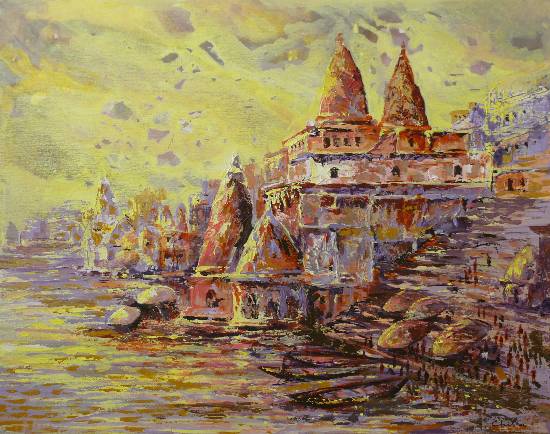Ghats in Varanasi
Ghats in Varanasi are riverfront steps leading to the banks of the River Ganga or Ganges. The city has 88 ghats. Most of the ghats are bathing and puja ceremony ghats, while two ghats are used exclusively as cremation sites.
Most Varanasi ghats were rebuilt after 1700 AD, when the city was part of the Maratha Empire. The patrons of current ghats are Marathas, Shindes (Scindias), Holkars, Bhonsles, and Peshwes (Peshwas). Many ghats are associated with legends or mythologies while many ghats are privately owned. Morning boat ride on the Ganges across the ghats is a popular tourist attraction.
Popular ghats
According to the puranic sources, there are five key ghats on the riverfront, important because of their association with a defining feature of the holy city of Kashi: Assi Ghat, Dashashwamedh Ghat, Manikarnika Ghat, Panchganga Ghat and Adi Keshav Ghat.

Assi Ghat
This ghat that used to lie at the confluence of the Ganges with the dry river Asi marks the traditional southern boundary of the city. Asisangameshwar Temple at the ghat finds mention in the Kashi Khand of Skanda Mahapurana. This ghat is very popular because it is one of the very few ghats that is linked with the city through a wide street. It is also the major ghat that is closest to Banaras Hindu University. Assi ghat name is given as it is the 80th ghat.
Dashashwamedh Ghat
Dashashwamedh Ghat is located close to Vishwanath Temple, and is probably the most spectacular ghat. Two Hindu mythologies are associated with it: According to one, Lord Brahma created it to welcome Lord Shiva. A group of priests daily perform in the evening at this ghat "Agni Pooja" (Worship to Fire) wherein a dedication is made to Lord Shiva, River Ganges, Surya (Sun), Agni (Fire), and the whole universe.
Manikarnika Ghat
Two legends are associated with Manikarnika Ghat. According to one, it is believed to be the place where Lord Vishnu dug a pit with his Chakra and filled it with his perspiration while performing various penances. While Lord Shiva was watching Lord Vishnu at that time, the latter's earring ("manikarnika") fell into the pit. According to the second legend, in order to keep Lord Shiva from moving around with his devotees, his consort Goddess Parvati hid her earrings, and asked him to find them, saying that they had been lost on the banks of the Ganges. Goddess Parvati's idea behind the fib was that Lord Shiva would then stay around, searching forever for the lost earrings. In this legend, whenever a body gets cremated at the Manikarnika Ghat, Lord Shiva asks the soul whether it has seen the earrings.
According to ancient texts, the owner of Manikarnika Ghat bought King Harishchandra as a slave and made him work on the Manikarnika at Harishchandra Ghat. Hindu cremations customarily take place here, though a majority of dead bodies are taken for cremation to the Manikarnika Ghat. According to other sources, Manikarnika Ghat is named after Jhansi ki Rani Laxmibhai.

Scindia Ghat
Scindia Ghat also known as Shinde Ghat borders Manikarnika to the north, with its Shiva temple lying partially submerged in the river as a result of excessive weight of the ghat's construction about 150 years ago. Above the ghat, several of Kashi's most influential shrines are located within the tight maze of alleys of Siddha Kshetra (Field of Fulfillment). According to tradition, Agni, the Hindu God of Fire was born here. Hindu devotees propitiate at this place Vireshwara, the Lord of all heroes, for a son.
Maan-Mandir Ghat
Maharaja Jai Singh II of Jaipur built this Ghat in 1770, as well as the Jantar Mantar equipped with ornate window casings along with those at Delhi, Jaipur, Ujjain, and Mathura. There is a fine stone balcony in the northern part of the ghat. Devotees pay homage here to the lingam of Someswar, the Lord of the Moon.
Lalita Ghat
The late King of Nepal built this Ghat in the northern region of Varanasi. It is the site of the Ganges Keshav Temple, a wooden temple built in typical Kathmandu style. The temple has an image of Pashupateshwar, a manifestation of Lord Shiva. Local festivals including musical parties and games regularly take place at the beautiful Assi Ghat which is at the end of the continuous line of ghats. It is a favorite site of painters and photographers. It is here at the Assi Ghat that Swami Pranabananda, the founder of Bharat Sevashram Sangha, attained 'Siddhi' (fulfilment/success) in his 'Tapasya' (endeavor) for Lord Shiva, under the auspices of Guru Gambhirananda of Gorakhpur.
Bachraj Ghat
The Jain Ghat or Bachraj Ghat is a Jain Ghat and has three Jain Temples located on the banks of the River. It is believed that the Jain Maharajas used to own these ghats.Bachraj Ghat has three Jain temples near the river's banks and one of them is a very ancient temple of Tirthankara Suparswanath.


Other Ghats
- The Maan-Sarowar Ghat was built by Man Singh of Amber.
- The Darbhanga Ghat was built by the Maharaja of Darbhanga
- Tulsidas wrote Rāmacaritamānasa at Tulsi Ghat.
- The Chet Singh Ghat, with a magnificent fort-like palace, is named after Chait Singh. The first raja of Benares was Balwant Singh, and his illegitimate son was Chet Singh. Chait Singh became Maharaja by bribing the Nawab of Awadh and secured his legacy over Balwant Singh's nephew Mahip Narayan Singh. Chet Singh's legacy followed by political squabbles with Governor General Warren Hastings. In the year of 1781, Warren Hastings sent his army to Chet Singh's fort and Chet Singh managed to escape, while Hastings's army was fighting outside the fort.
- The headquarters of the Sri Kashi Math Samsthan, a spiritual school followed by the Konkani speaking Goud Saraswat Brahmins, is located in Brahma Ghat.